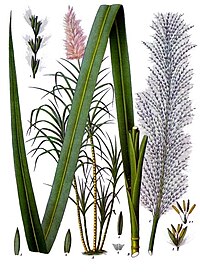
Photo from wikipedia
Intercropping helps diversification of crop production to fulfill diversified need of farmers. Sugarcane because of its initial slow growth can comfortably accommodate short-duration crops in between the rows. With the… Click to show full abstract
Intercropping helps diversification of crop production to fulfill diversified need of farmers. Sugarcane because of its initial slow growth can comfortably accommodate short-duration crops in between the rows. With the aim of assessing the profitability of sugarcane based-intercropping system, an experiment was taken up in randomized block design with five legume crops (green gram, black gram, cowpea, soybean and sunn hemp) as intercrops in sugarcane under wide row of planting (150 cm) along with sole sugarcane as control during 2016–2017 at ICAR-Sugarcane Breeding Institute, Coimbatore. Among the different intercropping systems followed, the yield attributes were nonsignificant except the number of millable cane (NMC/ha). The NMC recorded with sugarcane + soybean was significantly higher (116.5 thousands/ha) than control. Sugarcane intercropped with soybean has recorded significantly higher cane yield of 122.82 t/ha, followed by sugarcane intercropped with sunn hemp (117.31 t/ha) and black gram (116.38 t/ha), while sole crop of sugarcane has recorded the lowest cane yield of 74.30 t/ha. Among the five legume intercrops in sugarcane, sugarcane + soybean has recorded higher cane equivalent yield (CEY) of 132.0 t/ha, followed by sugarcane + green gram (119.4 t/ha). Sugarcane + sunn hemp has recorded higher LER of 1.39, followed by green gram (1.37) and soybean (1.21) when compared to sole crop of sugarcane. Weed smothering efficiency (WSE) was significantly higher in sugarcane + cowpea (36.3%) intercropping system followed by sunn hemp (32.3%) and soybean (32.0%) over the sole sugarcane (control). The highest gross return (Rs. 376,243/ha) was obtained from sugarcane + soybean followed by sugarcane + green gram (Rs. 340,242/ha), and it was lowest in sole sugarcane (Rs. 211,771/ha). Similarly, highest benefit–cost ratio (1.83) was observed in sugarcane + soybean, while lowest in sole sugarcane (1.06). On the basis of cane yield, cane equivalent yield and returns per rupee of investment, it is inferred that, among all the cropping systems, sugarcane + soybean found to be most profitable under wide row of planting than cultivation of sole sugarcane.
Journal Title: Sugar Tech
Year Published: 2018
Link to full text (if available)
Share on Social Media: Sign Up to like & get
recommendations!